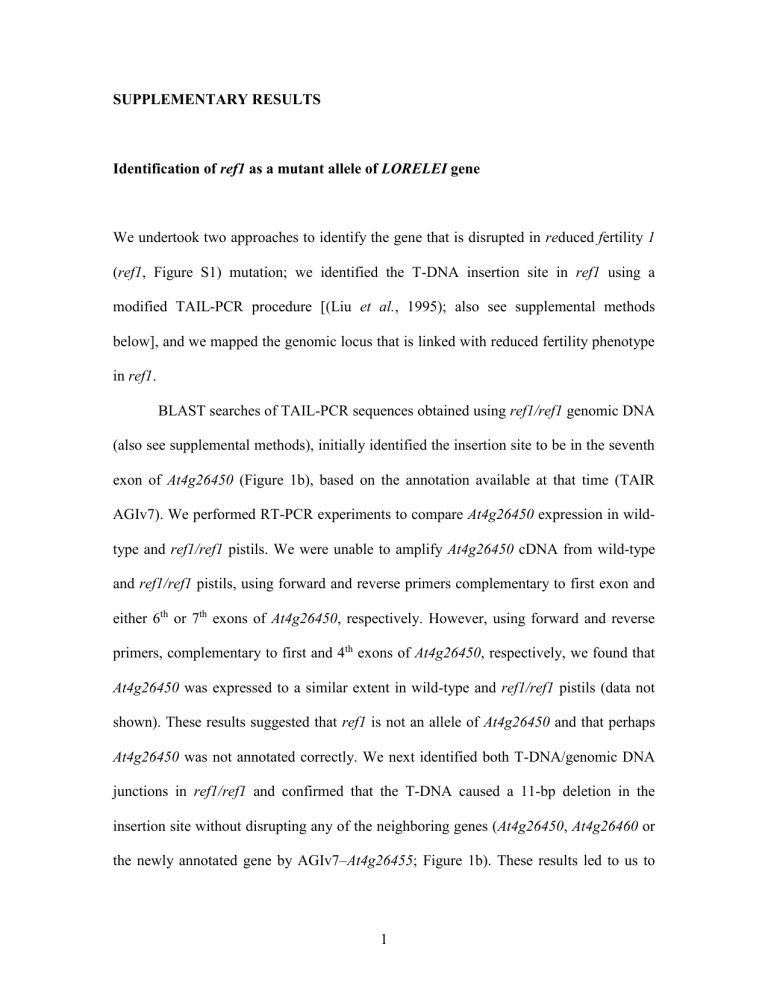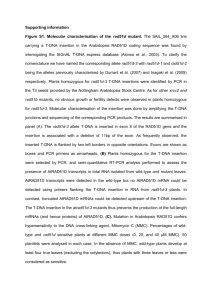TPJ_4177_sm_Tsukamoto_etal_Supplementary_text

SUPPLEMENTARY RESULTS
Identification of ref1 as a mutant allele of LORELEI gene
We undertook two approaches to identify the gene that is disrupted in re duced f ertility 1
( ref1 , Figure S1) mutation; we identified the T-DNA insertion site in ref1 using a modified TAIL-PCR procedure [(Liu et al.
, 1995); also see supplemental methods below], and we mapped the genomic locus that is linked with reduced fertility phenotype in ref1 .
BLAST searches of TAIL-PCR sequences obtained using ref1/ref1 genomic DNA
(also see supplemental methods), initially identified the insertion site to be in the seventh exon of At4g26450 (Figure 1b), based on the annotation available at that time (TAIR
AGIv7). We performed RT-PCR experiments to compare At4g26450 expression in wildtype and ref1/ref1 pistils. We were unable to amplify At4g26450 cDNA from wild-type and ref1/ref1 pistils, using forward and reverse primers complementary to first exon and either 6 th
or 7 th
exons of At4g26450 , respectively. However, using forward and reverse primers, complementary to first and 4 th exons of At4g26450 , respectively, we found that
At4g26450 was expressed to a similar extent in wild-type and ref1/ref1 pistils (data not shown). These results suggested that ref1 is not an allele of At4g26450 and that perhaps
At4g26450 was not annotated correctly. We next identified both T-DNA/genomic DNA junctions in ref1/ref1 and confirmed that the T-DNA caused a 11-bp deletion in the insertion site without disrupting any of the neighboring genes ( At4g26450 , At4g26460 or the newly annotated gene by AGIv7– At4g26455 ; Figure 1b). These results led to us to
1
conclude that T-DNA insertion in the intergenic region between At4g26455 and
At4g26460 resulted in reduced fertility phenotype.
To test this hypothesis, we obtained additional insertional alleles around the T-
DNA insertion site and reasoned that only insertions in the intergenic region between
At4g26450 and At4g26460 , not those in the regions that flank the insertion site, would phenocopy reduced fertility phenotype of ref1 . Consistent with our expectations, we found that only those insertions in close proximity of ref1 insertion site (b-f, Figure 1b and Table S1), but not in the flanking regions (g-j in Figure 1b and Table S1), segregated reduced seed-setting plants. Using gene prediction programs (GENSCAN; http://genes.mit.edu/GENSCAN.html and GeneMark; http://exon.gatech.edu/GeneMark/eukhmm.cgi
), we identified an ORF in the intergenic region spanning the insertion sites of T-DNA that phenocopied the reduced fertility phenotype of ref1 (b-f, Figure 1b and Table S1). We confirmed using RT-PCR experiments that this ORF was expressed in wild-type but not in ref1/ref1 pistils (data not shown). Subsequently, AGI v8 release and Capron et al . 2008 identified this ORF as
At4g26466 and LORELEI , respectively. Since four different alleles in this gene have been published (Capron et al.
, 2008), we renamed ref1 as lre-5 .
In addition to TAIL-PCR, we also investigated if ref1 mutation mapped to a single locus (Lukowitz et al.
, 2000), as SALK T-DNA mutant lines often contain T-DNA insertions in multiple loci (Alonso et al.
, 2003). We generated a mapping population by crossing a ref1/ref1 mutant line (from twice backcrossed population; Columbia ecotype) to wild type (Landsberg erecta ecotype). Using 450 reduced fertility segregants in a F2 population of 890 plants, we mapped ref1 to a single locus between At4g25400 and
2
At4g27270 (also see methods), a span of ~690 kb and containing ~196 genes. This region not only included the T-DNA insertion site in LORELEI, but also the une17 insertion site
(Pagnussat et al.
, 2005). Since reduced seed set and pollen tube reception phenotypes were ascribed to une17 mutant (Pagnussat et al.
, 2005), we sequenced UNE17 gene
( At4g26330 ; ~5kb region spanning the upstream, downstream and the coding sequence of
UNE17 ) in ref1/ref1 mutant. We found that there was neither a T-DNA nor any point mutation in the UNE17 gene in ref1/ref1 mutant suggesting that UNE17 is not REF1 and that T-DNA insertion in LORELEI gene is likely responsible for reduced fertility phenotypes observed in ref1 .
Three of the insertional mutants in LORELEI ( lre-4, lre-6, lre-7 ) not only phenocopied the reduced fertility phenotype of lre-5 (Tables 1 and 2) but also other developmental phenotypes in lre-5 such as aberrant pollen tube reception (Figure 1f,j,l), supernumerary pollen tube invasion into ovule (Figure 1g,k,m and Table 3) endosperm nuclei proliferation in embryo-less ovules (Table 4). In addition, in lre-4, lre-6, lre-7 , reduced fertility phenotype is female reproductive tissue-specific (Table 2) and mutant allele transmission in selfed progeny is significantly affected in all three alleles (Tables
S5 and S6). Based on these results, we concluded that LORELEI gene plays a role during pollen tube reception.
Female gametophyte development is normal in lre-5 ovules
Reciprocal crosses between lre-5/lre-5 and wild-type plants indicated that lre-5 mutation affected female gametophyte function (Table 1). To determine if LORELEI is required
3
for female gametophyte development, unpollinated, mature (stage7 female gametophyte) lre-5/lre-5 ovules were inspected either after fixation [by confocal laser scanning microscopy; (Christensen et al.
, 1997)] or sectioning [by light microscopy; (Sandaklie-
Nikolova et al.
, 2007)]. Unpollinated lre-5 female gametophytes were morphologically indistinguishable from wild type and contained four nuclei at the micropylar end; one egg nucleus, two synergid nuclei and one central cell nucleus (Figure 2a,c,g; Figure 3a,c).
Nuclear migration and cellularization of synergids, egg, central cells were similar in unpollinated lre-5 and wild-type female gametophytes. In particular, synergid cells, which are critical for mediating pollen tube reception, appeared normal in lre-5 female gametophytes; the cytoplasm and nucleus of the synergid cell were oriented toward the micropylar pole and the vacuoles were positioned toward the chalazal pole (Figure 2a,c).
In addition, there was no difference in any of the female gametophyte cell-specific marker expression [synergid cells, central cell, egg cell and antipodal cells; (Steffen et al.
, 2007)], between wild type and lre-5 (Figure S4 and Table S4), suggesting that cell specification and differentiation of all female gametophyte cells in lre-5 were normal.
Based on these results, we concluded that development of lre-5 female gametophytes was comparable to wild type.
SUPPLEMENTARY METHODS
Mutant screen
4
From each pool of 100 SALK T-DNA lines, ~600 T4 seeds (representing ~six seeds from each mutant line) were grown in soil. We screened ~6 seeds for each mutant line to enhance the chances of scoring at least one homozygous plant from each mutant line.
Siliques were screened for undeveloped ovules, abnormal seeds and reduced seed set after removing ovary walls under a dissecting scope (Stemi 2000, Carl Zeiss, Germany).
The lre-5 mutant was backcrossed twice to wild type and in the F2 generation, heterozygous and homozygous lre-5 mutant plants were identified as follows: selfed progeny were scored for reduced seed set and those lines that segregated only reduced seed setting plants were considered homozygous for lre-5 locus and those plants that segregated both full and reduced seed setting plants were considered heterozygous for lre-5 locus. A homozygous lre-5 plant was crossed to Landsberg erecta ecotype wild type to generate a mapping population and Columbia ecotype to generate a backcrossed mutant line that was used in all the experiments described in this study. After identifying
LORELEI gene, the heterozygous and homozygous lines were confirmed by PCR with gene-specific primers.
Identification of lre-5 locus by a modified TAIL-PCR procedure and mapping
Although reduced seed set phenotype was linked to Kanamycin resistance in lre-5 (Table
S3), we could not identify the flanking genomic sequence by TAIL-PCR with either Left
Border (LB)- or Right Border (RB)-specific primers in conjunction with Arbitrary
Degenerate (AD) primers described in (Liu et al.
, 1995). Since all the RB- and LBspecific primers reported by (Liu et al.
, 1995) are complementary to the end of RB and
5
LB sequences, and terminal sequences in T-DNA borders are known to be deleted during integration (Kim et al.
, 2003), we reasoned that TAIL-PCR could have failed due to deletion of T-DNA border sequences in lre-5 . So, we designed three new RB primers
(Table S7) complementary to a region in the RB that is distal to the end of RB sequence and used them in primary, secondary and tertiary reactions respectively. Six of the 12 AD primers reported by (Liu et al.
, 1995) in conjunction with these three RB primers successfully amplified nested TAIL-PCR products from lre-5/lre-5 genomic DNA. To identify the second lre-5 T-DNA/genomic DNA junction, LB and At4g26466 genespecific primers (Table S7) were used.
The lre-5 ( ref1 ) locus was mapped between At4g25400 and At4g27270 essentially as described (Lukowitz et al.
, 2000) using simple sequence length polymorphism (SSLP) markers (Salathia et al.
, 2007) and newly designed cleaved amplified polymorphic sequence (CAPS) markers in these genes (Table S7).
Computational analysis of LORELEI and related protein sequences
LORELEI and LLG sequences were aligned and boxshaded at
( http://www.ebi.ac.uk/Tools/clustalw2/index.html
) and ( http://mobyle.pasteur.fr/cgibin/MobylePortal/portal.py?form=boxshade ) respectively. Secretion signal sequence and
GPI-anchor attachment sites were
( http://bmbpcu36.leeds.ac.uk/prot_analysis/Signal.html
) predicted at and
(http://mendel.imp.ac.at/gpi/plant_server.html), respectively. Protein sequences were aligned using MAFFT (Katoh et al.
, 2002),
6
and the consensus phylogenetic tree with all highest probability bipartitions (‘allcompat’ tree) was approximated from the posterior probability distribution
resulting from an MCMC sampling of tree topologies performed using the program
MrBayes 2.1 (Huelsenbeck and Ronquist, 2001) and substitution parameters taken from the JTT amino acid substitution model (Jones et al.
, 1992).
REFERENCES
Alonso, J.M., Stepanova, A.N., Leisse, T.J., Kim, C.J., Chen, H., Shinn, P.,
Stevenson, D.K., Zimmerman, J., Barajas, P., Cheuk, R., Gadrinab, C.,
Heller, C., Jeske, A., Koesema, E., Meyers, C.C., Parker, H., Prednis, L.,
Ansari, Y., Choy, N., Deen, H., Geralt, M., Hazari, N., Hom, E., Karnes, M.,
Mulholland, C., Ndubaku, R., Schmidt, I., Guzman, P., Aguilar-Henonin, L.,
Schmid, M., Weigel, D., Carter, D.E., Marchand, T., Risseeuw, E., Brogden,
D., Zeko, A., Crosby, W.L., Berry, C.C. and Ecker, J.R. (2003) Genome-wide insertional mutagenesis of Arabidopsis thaliana . Science , 301 , 653-657.
Capron, A., Gourgues, M., Neiva, L.S., Faure, J.E., Berger, F., Pagnussat, G.,
Krishnan, A., Alvarez-Mejia, C., Vielle-Calzada, J.P., Lee, Y.R., Liu, B. and
Sundaresan, V. (2008) Maternal control of male-gamete delivery in Arabidopsis involves a putative GPI-anchored protein encoded by the LORELEI gene. Plant
Cell , 20 , 3038-3049.
7
Christensen, C.A., King, E.J., Jordan, J.R. and Drews, G.N. (1997)
Megagametogenesis in Arabidopsis wild type and the Gf mutant. Sex. Plant
Reprod.
10 , 49-64.
Huelsenbeck, J.P. and Ronquist, F. (2001) MRBAYES: Bayesian inference of phylogeny. Bioinformatics , 17 , 754-755.
Johnson, M.A., von Besser, K., Zhou, Q., Smith, E., Aux, G., Patton, D., Levin, J.Z. and Preuss, D. (2004) Arabidopsis hapless mutations define essential gametophytic functions. Genetics , 168 , 971-982.
Jones, D.T., Taylor, W.R. and Thornton, J.T. (1992) The rapid generation of mutation data matrices from protein sequences. Computer Applications in the Biosciences ,
8 , 275-282.
Kasahara, R.D., Portereiko, M.F., Sandaklie-Nikolova, L., Rabiger, D.S. and Drews,
G.N. (2005) MYB98 is required for pollen tube guidance and synergid cell differentiation in Arabidopsis . Plant Cell , 17 , 2981-2992.
Katoh, K., Misawa, K., Kuma, K. and Miyata, T. (2002) MAFFT: a novel method for rapid multiple sequence alignment based on fast Fourier transform. Nucleic Acids
Res.
30 , 3059-3066.
Kim, S.R., Lee, J., Jun, S.H., Park, S., Kang, H.G., Kwon, S. and An, G. (2003)
Transgene structures in T-DNA-inserted rice plants. Plant Mol. Biol . 52 , 761-773.
Liu, Y.G., Mitsukawa, N., Oosumi, T. and Whittier, R.F. (1995) Efficient isolation and mapping of Arabidopsis thaliana T-DNA insert junctions by thermal asymmetric interlaced PCR. Plant J . 8 , 457-463.
8
Lukowitz, W., Gillmor, C.S. and Scheible, W.R. (2000) Positional cloning in
Arabidopsis . Why it feels good to have a genome initiative working for you. Plant
Physiol . 123 , 795-805.
Pagnussat, G.C., Yu, H.J., Ngo, Q.A., Rajani, S., Mayalagu, S., Johnson, C.S.,
Capron, A., Xie, L.F., Ye, D. and Sundaresan, V. (2005) Genetic and molecular identification of genes required for female gametophyte development and function in Arabidopsis . Development , 132 , 603-614.
Salathia, N., Lee, H.N., Sangster, T.A., Morneau, K., Landry, C.R., Schellenberg,
K., Behere, A.S., Gunderson, K.L., Cavalieri, D., Jander, G. and Queitsch, C.
(2007) Indel arrays: an affordable alternative for genotyping. Plant J . 51 , 727-
737.
Sandaklie-Nikolova, L., Palanivelu, R., King, E.J., Copenhaver, G.P. and Drews,
G.N. (2007) Synergid cell death in Arabidopsis is triggered following direct interaction with the pollen tube. Plant Physiol . 144 , 1753-1762.
Steffen, J.G., Kang, I.H., Macfarlane, J. and Drews, G.N. (2007) Identification of genes expressed in the Arabidopsis female gametophyte. Plant J . 51 , 281-292.
9







